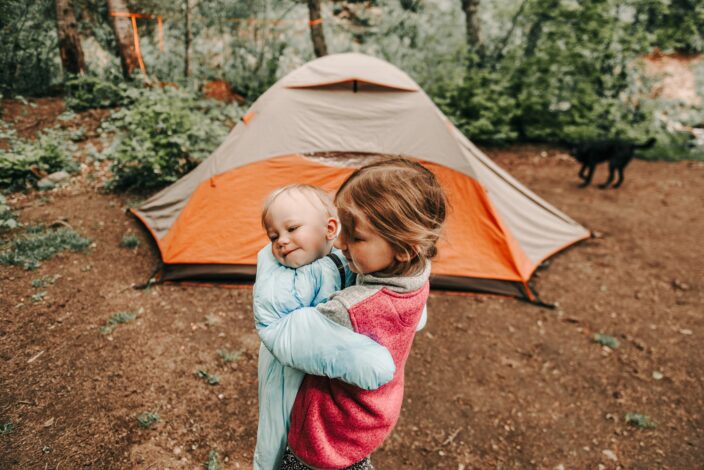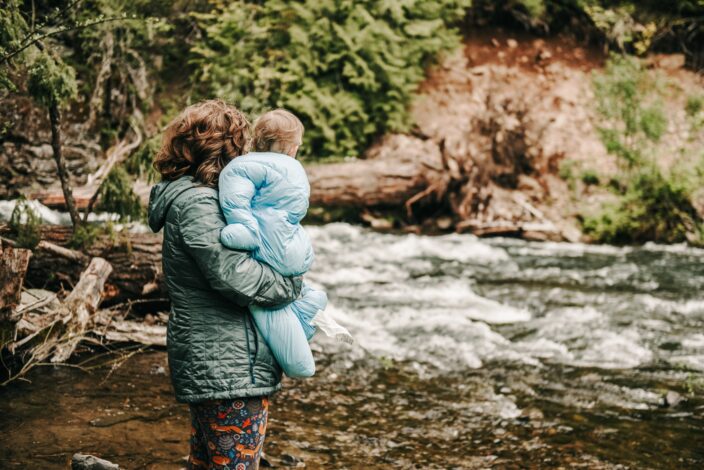How to Choose a Baby-Friendly Campsite
IN PARTNERSHIP WITH OUR FRIENDS AT MORRISON OUTDOORS
Camping while your kiddos are babies can be an incredible experience, making memories and starting traditions that last for years to come. However, the preparation and execution of a camping trip with a baby in tow can be daunting. Everything from how to dress your baby, what gear to bring, and even what to eat can get overwhelming. Luckily, we’re here to help! In this blog series, we will cover various topics and provide tips and advice to make camping with a baby a huge success! In this article, we provide tips and things to look for when choosing a baby-friendly campground and campsite.

Tips for Choosing a Baby-Friendly Campground
Every campground offers its own unique mix of views, recreation options, amenities, etc. Start by researching what the campground has to offer by checking their website. Not sure where you want to stay yet? Websites such as Recreation and Campendium can help you find a campground with availability in your desired location along with what amenities are offered. Regardless of where you stay, try to book in advance so you find a place to meet your needs (especially with a baby in tow!). Here are some things to consider when searching for a baby-friendly campground:
Start Close to Home
During the first few camping trips, consider choosing a campground that is fairly close to home (within an hour). This is a great way to work out any kinks (such as forgetting a favorite blanket or leaving the wipes on the counter). If your baby is just not having it, you can pack up and head home, trying again another time.
Access to Amenities
Choosing a less-rugged campground that offers bathrooms, showers, and even a playground can help tremendously when you have a baby in tow. These luxuries come in handy when dealing with situations such as an unexpected blowout or mud adventure with a limited supply of wipes.
Choose a Campground with Recreational Options
If possible, choose a “recreation-included” campground to reduce driving time. The first time we camped with my oldest, we chose a site that included a beach and hiking trails within walking distance. This helped reduce the in-and-out of the car seat and finding a parking spot chaos. It also gave us the flexibility to bail on an activity if he needed an extra nap.
Proximity to Essentials
With the chaos that can come with packing for a camping trip, it’s easy to forget something, whether it’s the hotdogs or the baby wipes (both of which have happened to me). Being close to a grocery store or gas station can make it easy to grab what you forgot (or didn’t realize you needed).
Near Desired Activities
If you are planning to visit a specific location (such as a National Park, a popular trail, etc.), finding a campground close by takes some of the stress off the commute to and from those areas (nobody like to have to drive an hour back to the campground if they can avoid it!).

Tips for Choosing a Baby-Friendly Campsite
Now that you have a campground picked out, there are some factors to keep in mind when choosing a campsite to fit the needs of your family. Looking at a campground map with labeled campsites can help you determine which will work best. Here are some things to consider:
Proximity to Other Campers
Choosing a campsite that is more isolated (or finding a campground where sites are a bit more spread out) can help to reduce noise issues. Some campers like to stay up all night, which can make it hard to settle your baby. Alternatively, if your baby wakes in the night or is having a hard time in their new surroundings, being further from others means you’re less likely to disturb your neighbors.
Get to Know your Neighbors
It’s not always possible to find a campsite that is a good distance from others. Introducing yourself and chatting with fellow campers in nearby campsites is a great way to show them you have a tiny adventurer in tow. This can result in far more understanding fellow-campers who will hopefully limit the rowdiness or be more accepting if they hear cries in the night.
Amount of Sunlight
Finding a site that offers some shade in the summer can cut down on the heat in the tent and protect your baby’s sensitive skin from over-exposure to sunlight. Alternatively, sunny spots can help warm up a campsite during the fall and winter, making for a more comfortable trip.
Near restrooms and water sources
Being close to bathrooms and showers is convenient in case you need to quickly clean off baby after a messy adventure or just want one less thing to stress about when getting up in the middle of the night (finding a bathroom in the dark is not a happy adventure, even without a little one!).
Campground Intersections
Some campgrounds have various intersections that can get busy and noisy as cars come and go. They can also be dangerous if your baby is a fast crawler. Choosing a site that is a good distance from these intersections reduces noise pollution and helps keep your family safe. Are there amenities you prefer when camping with a baby? Do you have a favorite baby-friendly campground? Let us know in the comments below!
Other Articles in this Series:
- How to Dress Baby for Cold-Weather Camping
- Essential Baby Camping Gear
- Tips for Sleeping in a Tent with Baby
- Favorite Baby Camping Foods
Photos by Deanna Curry
ABOUT OUTGROWN
OutGrown is a 501(c)(3) nonprofit that works to create a world where everyone can enjoy the physical and mental benefits of spending time outside. We are focused on creating opportunities and removing barriers to access so families with babies and young children can take their first steps outside. We believe all families have the right to connect with nature, benefit from spending time outdoors and be inspired to a lifelong love of nature. Since its grassroots inception in 2013, OutGrown is a growing community of 280,000 families and over 300 volunteer Branch Ambassadors. More information on all of our programs can be found at WeAreOutGrown.org
EDITORS NOTE:
We hope you enjoyed reading this article from OutGrown. We’re working hard to provide our community with content and resources that inform, inspire, and entertain you.
But content is not free. It’s built on the hard work and dedication of writers, editors, and volunteers. We make an investment in developing premium content to make it easier for families with young children to connect with nature and each other. We do not ask this lightly, but if you can, please make a contribution and help us extend our reach.
Related Content




Comments